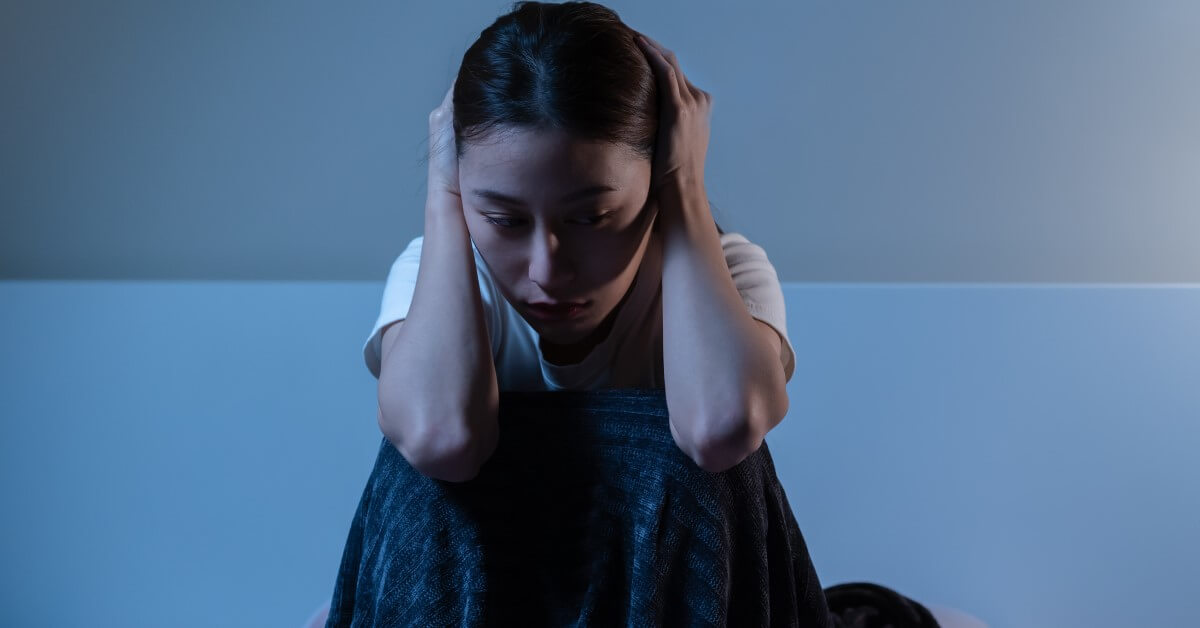
What is a Nightmare? | When Should You Be Concerned? |What Are the Treatments? | What’s the Takeaway?
Overview
Sleep, diet, and exercise are considered one of the three pillars of good health as they play a critical role in multiple cognitive and physiological functions.
Studies have consistently shown that sleep deprivation can cause a higher risk of infectious diseases, cardiovascular disease, and depression.[1]
You can’t go wrong if you pay attention to your sleep habits and try to get the recommended 7-9 hours of sleep per night. But for some, it’s just more complex.
Unfortunately, several factors can negatively affect a person’s ability to fall asleep and stay asleep for the recommended duration. One of these factors is the phenomenon we know as nightmares. Everyone has had one, and for the most part, this is nothing to be concerned about.
But sometimes, nightmares can be a cause for concern. Keep reading to learn more about nightmares and when you should seek help from your doctor.
What is a Nightmare?
At its most basic level, a nightmare is a frightening or unsettling dream that causes the sleeper to wake up.[2] It’s considered a parasomnia – or sleep disorder. The causes of nightmares are quite varied but usually signify a normal stress response,[3] although it can also be associated with depression and anxiety.[2]
Nightmares can happen more regularly in people with post-traumatic stress disorder (PTSD) or acute stress disorder (ASD).[4] They can be a common side effect with certain medications (most commonly beta-blockers).[5]
Although it’s difficult to fully quantify due to differing perceptions of what constitutes a nightmare, it’s estimated that up to 85 percent of adults experience them at least once a year.
Nightmares happen across all genders, age groups, and ethnicities, but they are more prevalent in females.[6] Why this is the case is not fully understood, and further research is needed.
When Should You Be Concerned?
If the intensity and frequency of nightmares increase and interfere with the quality and quantity of sleep, it may be time to consider seeking medical help.
A nightmare disorder can cause significant distress and impairment in social, occupational, or other areas where one needs to function.[7]
The features of the nightmares experienced with this disorder can include:
· Frequent, recurring nightmares happening in the latter part of sleep
· The dreams are intense, distressing, and vivid
· Harm, conflict, accidents, and other strongly negative experiences feature in these dreams
· Sweating, anxiety, and accelerated heart rate upon waking from an episode
As a result of the terrifying sleep disruptions and subsequent sleep deprivation, the person experiencing a nightmare disorder can develop other sleep disorders, heart problems, chronic fatigue, increased anxiety, and a fear of falling asleep, known as somniphobia.
In people not previously diagnosed with a psychiatric disorder, recurring nightmares may indicate depression, anxiety disorders, schizophrenia, and borderline personality disorder.
What Are the Treatments?
There’s no specific method or tool to diagnose nightmare disorder other than the reported frequency and intensity of nightmares by the patient and the resulting impacts on their quality of life. There are two main routes of treatment for nightmare disorder.
Medications: Medication is rarely prescribed for nightmares, but some types can be prescribed to address the underlying cause, such as Prazosin for PTSD[8].
Image Rehearsal Therapy (IRT): This cognitive approach reduces the frequency of recurrent nightmares.[9] In this form of therapy, the patient comes up with an alternate ending to their nightmare while awake and rehearses it until it no longer feels threatening.
Sleep hygiene: [10] Some reasonably simple lifestyle changes focusing on sleep can complement any other treatment or even reduce nightmares. A consistent sleep schedule and routine, a sleep environment conducive to quality sleep (a cool, dark room free of distracting noise), and avoidance of heavy or spicy food, alcohol, caffeine, or exercise close to bedtime are parts of this strategy.
Other Methods: Cognitive Behavioral Therapy (CBT), hypnosis, lucid dreaming therapy, and progressive deep muscle relaxation may all be used to help manage nightmares.[10]
What’s the Takeaway?
Nightmares happen to everyone. Unless they occur frequently, they are normal parts of life and leave you in enough distress to spill over into your waking hours. If this describes your situation, please contact your healthcare provider.
If you seek help, a description of the nightmares, information about your sleep quality, and any abnormal behaviors that may happen during sleep would be helpful.
Additionally, a list of any medications and any history of substance use and traumatic events will help determine the best course of treatment to get you to sleep well again as soon as possible.
References:
- Irwin M. R. (2015). Why sleep is important for health: a psychoneuroimmunology perspective. Annual review of psychology, 66, 143–172. https://doi.org/10.1146/annurev-psych-010213-115205
- Abdul-Razzak, K. K., & Alkhatatbeh, M. J. (2021). Nightmares and bad dreams among individuals with musculoskeletal pain: a link to vitamin D and calcium. Research in psychotherapy (Milano), 24(2), 533. https://doi.org/10.4081/ripppo.2021.533
- Pagel J. F., Jr (1989). Nightmares. American family physician, 39(3), 145–148.
- Koren, D., Fleisher, W., & Neylan, T. C. (2006, April 1). Sleep disturbance as the hallmark of post-traumatic stress disorder. American Journal of Psychiatry. https://ajp.psychiatryonline.org/doi/abs/10.1176/ajp.146.6.697.
- Thompson, D. F., & Pierce, D. R. (1999, January). Drug-Induced Nightmares – Dennis F Thompson, Dana Reid Pierce, 1999. SAGE Journals. https://journals.sagepub.com/doi/10.1345/aph.18150.
- Li, S. X., Zhang, B., Li, A. M., & Wing, Y. K. (2010). Prevalence and correlates of frequent nightmares: a community-based 2-phase study. Sleep, 33(6), 774–780. https://doi.org/10.1093/sleep/33.6.774
- Gieselmann, A., Ait Aoudia, M., Carr, M., Germain, A., Gorzka, R., Holzinger, B., Kleim, B., Krakow, B., Kunze, A. E., Lancee, J., Nadorff, M. R., Nielsen, T., Riemann, D., Sandahl, H., Schlarb, A. A., Schmid, C., Schredl, M., Spoormaker, V. I., Steil, R., van Schagen, A. M., … Pietrowsky, R. (2019). Aetiology and treatment of nightmare disorder: State of the art and future perspectives. Journal of sleep research, 28(4), e12820. https://doi.org/10.1111/jsr.12820
- Aurora, R. N., Zak, R. S., Auerbach, S. H., Casey, K. R., Chowdhuri, S., Karippot, A., Maganti, R. K., Ramar, K., Kristo, D. A., Bista, S. R., Lamm, C. I., Morgenthaler, T. I., Standards of Practice Committee, & American Academy of Sleep Medicine (2010). Best practice guide for the treatment of nightmare disorder in adults. Journal of clinical sleep medicine : JCSM : official publication of the American Academy of Sleep Medicine, 6(4), 389–401.
- Nappi, C. M., Drummond, S. P., Thorp, S. R., & McQuaid, J. R. (2010). Effectiveness of imagery rehearsal therapy for the treatment of combat-related nightmares in veterans. Behavior therapy, 41(2), 237–244. https://doi.org/10.1016/j.beth.2009.03.003
- Morgenthaler, T. I., Auerbach, S., Casey, K. R., Kristo, D., Maganti, R., Ramar, K., Zak, R., & Kartje, R. (2018). Position Paper for the Treatment of Nightmare Disorder in Adults: An American Academy of Sleep Medicine Position Paper. Journal of clinical sleep medicine : JCSM : official publication of the American Academy of Sleep Medicine, 14(6), 1041–1055. https://doi.org/10.5664/jcsm.7178


